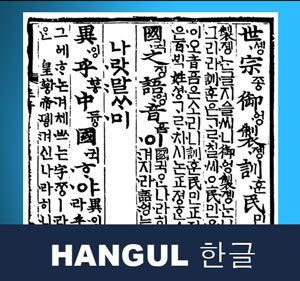Taekwondo 태권도Taekwondo Preschool
Promotion from one geup to the next can proceed rapidly in some schools, since schools often allow geup promotions every two, three, or four months. Students of geup rank learn the most basic techniques first, and then move on to more advanced techniques as they approach first dan. Many of the older and more traditional schools often take longer to allow students to test for higher ranks than newer, more contemporary schools, as they may not have the required testing intervals. View Taekwondo belt levels »

Sorting Order ( 한글 hangul )
Hangul is a featural alphabet of 24 consonant and vowel letters. However, instead of being written sequentially like the letters of the Latin alphabet, Hangul letters are grouped into blocks, such as 한 han, each of which transcribes a syllable.
The alphabetical order of Hangul does not mix consonants and vowels as the Latin, Cyrillic, and Greek alphabets do. Rather, the order is that of the Indic type, first velar consonants, then coronals, labials, sibilants, etc. However, the vowels come after the consonants rather than interspersed between them as in the Indic systems.

Historical Orders
The consonantal order of the Hunmin Jeongeum in 1446 was,
- ㄱ ㅋ ㆁ ㄷ ㅌ ㄴ ㅂ ㅍ ㅁ ㅈ ㅊ ㅅ ㆆ ㅎ ㅇ ㄹ ㅿ
and the order of vowels was,
- ㆍ ㅡ ㅣ ㅗ ㅏ ㅜ ㅓ ㅛ ㅑ ㅠ ㅕ
In 1527, Choe Sejin reorganized the alphabet:
- ㄱ ㄴ ㄷ ㄹ ㅁ ㅂ ㅅ ㆁ ㅋ ㅌ ㅍ ㅈ ㅊ ㅿ ㅇ ㅎ
- ㅏ ㅑ ㅓ ㅕ ㅗ ㅛ ㅜ ㅠ ㅡ ㅣ ㆍ
This is the basis of the modern alphabetic orders. It was before the development of the Korean tense consonants and the double letters that represent them, and before the conflation of the letters ㅇ (null) and ㆁ (ng). Thus when the South Korean and North Korean governments implemented full use of Hangul, they ordered these letters differently, with South Korea grouping similar letters together, and North Korea placing new letters at the end of the alphabet.
South Korean order
In the Southern order, double letters are placed immediately after their single counterparts. No distinction is made between silent and nasal ㅇ:
- ㄱ ㄲ ㄴ ㄷ ㄸ ㄹ ㅁ ㅂ ㅃ ㅅ ㅆ ㅇ ㅈ ㅉ ㅊ ㅋ ㅌ ㅍ ㅎ
- ㅏ ㅐ ㅑ ㅒ ㅓ ㅔ ㅕ ㅖ ㅗ ㅘ ㅙ ㅚ ㅛ ㅜ ㅝ ㅞ ㅟ ㅠ ㅡ ㅢ ㅣ
The modern monophthongal vowels come first, with the derived forms interspersed according to their form: first added i, then iotized, then iotized with added i. Diphthongs beginning with w are ordered according to their spelling, as ㅗ or ㅜ plus a second vowel, not as separate digraphs.
The order of the final letters (받침) is,
- (none) ㄱ ㄲ ㄳ ㄴ ㄵ ㄶ ㄷ ㄹ ㄺ ㄻ ㄼ ㄽ ㄾ ㄿ ㅀ ㅁ ㅂ ㅄ ㅅ ㅆ ㅇ ㅈ ㅊ ㅋ ㅌ ㅍ ㅎ
("None" means there is no final letter.)
Every word begins with a consonant that is followed by a vowel (ex. ㄷ + ㅏ = 다). Some words have a final consonant (받침), such as "달" and "닭". Then, there are a total of 399 possible combinations for "two-letter words" and 10 773 possible combinations for words with more than two "letters" (27 possible final endings, 받침), for a total of 11 172 possible combinations of Hangul "letters" to form characters.
North Korean order
North Korea maintains a more traditional order:
- ㄱ ㄴ ㄷ ㄹ ㅁ ㅂ ㅅ ㅈ ㅊ ㅋ ㅌ ㅍ ㅎ ㄲ ㄸ ㅃ ㅆ ㅉ ㅇ
ㅇ used as an initial, goes at the very end, as it is a placeholder for the vowels which follow. (A syllable with no final is ordered before all syllables with finals, however, not with null ㅇ.)
The new, double, letters are placed at the end of the consonants, just before the null ㅇ, so as not to alter the traditional order of the rest of the alphabet.
The order of the vowel letters is,
- ㅏ ㅑ ㅓ ㅕ ㅗ ㅛ ㅜ ㅠ ㅡ ㅣ ㅐ ㅒ ㅔ ㅖ ㅚ ㅟ ㅢ ㅘ ㅝ ㅙ ㅞ
All digraphs and trigraphs, including the old diphthongs ㅐ and ㅔ, are placed after the simple vowels, again maintaining Choe's alphabetic order.
The order of the final letters is,
- (none) ㄱ ㄳ ㄴ ㄵ ㄶ ㄷ ㄹ ㄺ ㄻ ㄼ ㄽ ㄾ ㄿ ㅀ ㅁ ㅂ ㅄ ㅅ ㅇ ㅈ ㅊ ㅋ ㅌ ㅍ ㅎ ㄲ ㅆ
Unlike when it is initial, this ㅇ is pronounced, as the nasal ㅇ ng, which occurs only as a final in the modern language. The double letters are placed to the very end, as in the initial order, but the combined consonants are ordered immediately after their first element.
Related Articles
Taekwondo Basics
Here is where you can learn more about Taekwondo 태권도. Knowing the fundamental basics is very important for your learning path as you build your skills and knowledge. There are certain rules that need to be followed to show respect to the master ( 사범님 sabeomnim ), the instructors ( 교사님 gyosannim ), other practitioners and to the martial arts. They vary between schools but many have similar rules and guidelines. For more information View Taekwondo Basics »
There are five tenets defined in the International Taekwondo Federation (ITF) and several more in World Taekwondo (WT).
Integrity ( 염치 yeom-chi ): "Although it may be similar, this form of integrity takes on a more wider role then defined in the common dictionary. In taekwondo, integrity means not only to determine what is right or wrong but also having the conscience to feel guilt if one has done wrong and to have the integrity stand up for what is right." View Taekwondo Tenets »
RESOURCES
This article uses material from the Wikipedia article "Hangul" which is released under the Creative Commons Attribution-Share-Alike License 3.0.









